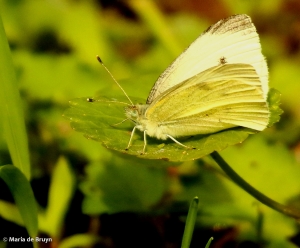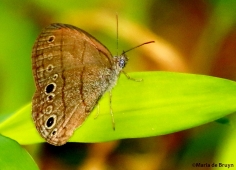 When a butterfly like the cabbage white (Pieris rapae) alights on a flower or leaf, we sometimes have a little time to see them more clearly and appreciate their beauty; capturing a photo for leisurely viewing gives us the chance to focus on details. And those details are important if we want to determine their correct scientific names since entomologists have differentiated many species and sub-species, sometimes on the basis of factors such as the shape of their spots.
When a butterfly like the cabbage white (Pieris rapae) alights on a flower or leaf, we sometimes have a little time to see them more clearly and appreciate their beauty; capturing a photo for leisurely viewing gives us the chance to focus on details. And those details are important if we want to determine their correct scientific names since entomologists have differentiated many species and sub-species, sometimes on the basis of factors such as the shape of their spots.
One butterfly pair that can be puzzling are the silvery checkerspot (Chlosyne nycteis, top), with a small white center to one of its spots in the lower row, and the pearl crescent (Phyciodes tharos), which was abundant this year.



The Eastern comma (Polygonia comma) and question mark (Polygonia interrogationis) look really similar, too. Perhaps the difference in their distinguishing underside marking is really apparent to proofreaders.


The easiest way to distinguish the endangered monarch (Danaus plexippus) and the viceroy (Limenitis archippus) is that the viceroy has a black stripe running horizontally across its lower wings.



The swallowtails are always a favorite, including the Eastern tiger swallowtail (Papilio glaucus) with differently colored males (yellow) and females (yellow and also blue).



The zebra swallowtail (Protographium marcellus) really catches your eye as it flutters about, while the pipevine swallowtail (Battus philenor) is a little more subdued.


The red spotted purples (Limenitis arthemis) come in different variations; this one enjoyed the hummingbird nectar this summer.


Another new butterfly for me this year was the great spangled fritillary (Speyeria cybele), which I enjoyed seeing as they enjoyed common milkweed (Asclepias syriaca) at the Horton Grove Nature Reserve.


 The hackberry emperor (Asterocampa celtis) turned up at Jordan Lake, while the common buckeye (Junonia coenia) – whose beauty is anything but common! – was in my yard and various nature reserves. I also observed a pair getting ready to propagate the next generation.
The hackberry emperor (Asterocampa celtis) turned up at Jordan Lake, while the common buckeye (Junonia coenia) – whose beauty is anything but common! – was in my yard and various nature reserves. I also observed a pair getting ready to propagate the next generation.




Some of the tinier butterflies are delicate beauties, like the Summer azure (Celastrina neglecta), the gray hairstreak – which can look brown (Strymon melinus), the Eastern tailed-blue (Cupido comyntas) and the Carolina satyr (Hermeuptychia sosybius).




To end, here are two more beauties that I had the privilege to see this year. I hope seeing these butterflies and those in my previous blog brightened your day, especially if you have been dealing with sorrow as I have while this year approaches its end.


Southern pearly eye (Lethe portlandia) and Northern pearly-eye (Enodia anthedon)

Thank you for sharing your story and beautiful pictures of a variety of butterflies. I always learn more about nature from your blog. Thanks😀
LikeLike
Thanks, Malai – I always appreciate your leaving comments on the blog page.
LikeLike
You have taken some beautiful photos over the year and it is good to share such positive images of the natural world. I hope your spirits can be uplifted. Some years can be very challenging.
LikeLike
Thank you, Navasolanature. The past couple years have been challenging; the photography has helped relieve stress and get my mind in a calm and appreciative state. I hope we all have much joy, beauty and good health in the coming year!
LikeLike
Exquisite! I don’t see how butterfly photos can get better than this. I look forward to much more of your excellent images of a beautiful world next year and beyond.
LikeLike
That is kind of you to say, Phyllis. I’m glad you enjoyed them as I put lower resolution photos on the blog but they still often look fairly good. Butterflies are often so pretty that they just lend themselves to looking good in photos. I will do one more blog this year and then look forward to next year – I’m glad you are looking forward to them and in the meantime, I wish you a great start to 2016!
LikeLike